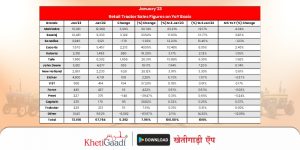Agricultural expert Dr. N.C. Tripathi recently stated that millet can be grown even in low-water or drought-affected areas. The government is encouraging farmers to cultivate millet and is also providing them with mini seed kits. Millet crops are ready for harvest within 65 to 70 days.
KhetiGaadi always provides right tractor information
Millet: A Beneficial Crop for Drought-Prone Areas
Millet is an excellent choice for farmers in areas affected by drought, particularly as a Kharif crop. It is not only a nutritious grain but also a valuable fodder. The fodder produced from millet is highly nutritious. Farmers can start cultivating millet with the onset of the monsoon season, and the crop matures within 65 to 70 days. Millet farming is also cost-effective.
If you wish to know organic methods to increase your overall cultivation yield, please call KhetiGaadi counsellor on 07875114466 or write an email to connect@khetigaadi.com
Government Support for Millet Cultivation
According to Dr. N.C. Tripathi from the Agricultural Science Centre, Niyamatpur, the government is actively promoting millet cultivation. Farmers are being provided with mini seed kits to assist in this process. Millet requires minimal irrigation and does not need excessive fertilizers. It can be grown at a very low cost.
Ideal Soil Conditions for Millet
Millet farming is best suited for loam, sandy loam, and sandy soils. It is important that the field chosen for millet cultivation has good drainage, as waterlogging can destroy the crop. Before the rainy season, farmers should Plow the soil twice using a soil-turning Plow or a disc harrow. After that, the field should be levelled and prepared for planting.
Varieties and Planting Time
There are several varieties of millet that take different times to mature. Varieties that take longer (80 to 90 days) should be sown in the first week of July. Medium-duration varieties (70 to 80 days) should be planted by July 10, while the faster-growing varieties (65 to 70 days) can be sown between July 10 and July 20. For planting millet, 4 to 5 kg of seed per hectare is needed. If planted in rows, there should be a spacing of 45 to 50 cm between rows and 10 to 15 cm between plants.
Fertilization for Healthy Growth
For strong and healthy millet plants, 5 tons of well-decomposed cow dung or vermicompost should be used. In addition, farmers should apply around 44 kg of urea, 250 kg of single super phosphate, and 87 kg of DAP at the time of planting. After rainfall, 40 kg of nitrogen and 40 kg of phosphorus per hectare can be applied. The expert also advised that fertilizer use can be adjusted based on soil testing results.
Stay tuned with us on our WhatsApp channel for more real time updates on various agriculture related schemes and innovative cultivation methods aimed at supporting our hardworking farmers.
For more detailed information, visit https://khetigaadi.com/ regularly!
To know more about tractor price contact to our executive






